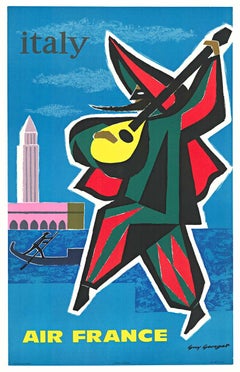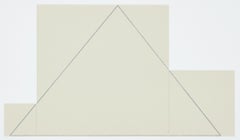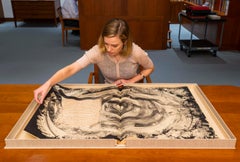Guy Georget Figurative Prints
to
1
1
Overall Width
to
Overall Height
to
1
16
834
373
349
308
1
1
1
1
1
1
1
1
1
1
1
Artist: Guy Georget
Original Air France Italy, scene from Venice, vintage travel poster
By Guy Georget
Located in Spokane, WA
Original Air France - "Italy"; U. S. edition in English. Size 24.5" x 39.5" Professional acid-free archival linen backed, ready to frame. Excellent condition lithograph. The ...
Category
1960s Abstract Geometric Guy Georget Figurative Prints
Materials
Lithograph
$958 Sale Price
20% Off
Related Items
Untitled (Mangold 1977.02; Parasol RM12), Robert Mangold
By Robert Mangold
Located in Fairfield, CT
Artist: Robert Mangold (1937)
Title: Untitled (Mangold 1977.02; Parasol RM12), from Multiple Panel Paintings suite
Year: 1992
Edition: 300, plus proofs
...
Category
1990s Abstract Geometric Guy Georget Figurative Prints
Materials
Screen
$3,676 Sale Price
20% Off
H 11.625 in W 23.875 in
The Departure of the Argonaut Francesco Clemente (bound book) Alberto Savinio
By Francesco Clemente
Located in New York, NY
The Departure of the Argonaut (1918) is the travelogue and wartime diary of Alberto Savinio, one of the seminal figures in twentieth-century Italian arts and letters. Clemente's acco...
Category
1980s Abstract Guy Georget Figurative Prints
Materials
Lithograph
$7,500
H 26 in W 20 in D 2 in
Untitled (Mangold 1977.02; Parasol RM12), Robert Mangold
By Robert Mangold
Located in Fairfield, CT
Artist: Robert Mangold (1937)
Title: Untitled (Mangold 1977.02; Parasol RM12), from Multiple Panel Paintings suite
Year: 1992
Edition: 300, plus proofs
...
Category
1990s Abstract Geometric Guy Georget Figurative Prints
Materials
Screen
$3,676 Sale Price
20% Off
H 11.625 in W 23.875 in
Landscape by Moonlight, Barges in Vietnam lithograph by Vietnamese Master
By Dang Lebadong
Located in Norwich, GB
Wonderful original original artist's proof lithograph by Vietnamese/French Master Dang Lebadang. Marked EA (for "Epreuve d'Artiste" lower left, signed lo...
Category
1960s Abstract Impressionist Guy Georget Figurative Prints
Materials
Lithograph
$450
H 18.9 in W 0.4 in D 24.81 in
1920 German Expressionist Figurative Lithograph "The Forest" Paul Kleinschmidt
By Paul Kleinschmidt
Located in Surfside, FL
Paul Kleinschmidt, (1883–1949)
"The Forest"
Lithograph on Cream Paper
1920
Frame: 21" X 17"
Image: 10.75" X 8.5"
An expressionist forest scene with pine trees
Provenance: bears label...
Category
1920s Abstract Guy Georget Figurative Prints
Materials
Lithograph, Paper
Rare 1923 Cubist Reuven Rubin Woodcut Woodblock Print Israeli Hasidic Judaica
By Reuven Rubin
Located in Surfside, FL
This is from the original first edition 1923 printing. there was a much later edition done after these originals.
These are individually hand signed in pencil by artist as issued.
This listing is for the one print. the other documentation is included here for provenance and is not included in this listing.
The various images inspired by the Jewish Mysticism and rabbis and mystics of jerusalem and Kabbalah is holy, dramatic and optimistic Rubin succeeded to evoke the spirit of life in Israel in those early days.
They are done in a modern art style influenced by German Expressionism, particularly, Ernst Barlach, Ernst Ludwig Kirchner, and Franz Marc, as introduced to Israel by Jakob Steinhardt, Hermann Struck and Joseph Budko.
Reuven Rubin 1893 -1974 was a Romanian-born Israeli painter and Israel's first ambassador to Romania.
Rubin Zelicovich (later Reuven Rubin) was born in Galati to a poor Romanian Jewish Hasidic family. He was the eighth of 13 children. In 1912, he left for Ottoman-ruled Palestine to study art at Bezalel Academy of Art and Design in Jerusalem. Finding himself at odds with the artistic views of the Academy's teachers, he left for Paris, France, in 1913 to pursue his studies at the École Nationale Supérieure des Beaux-Arts. He was of the well known Jewish artists in Paris along with Marc Chagall and Chaim Soutine,
At the outbreak of World War I, he was returned to Romania, where he spent the war years.
In 1921, he traveled to the United States with his friend and fellow artist, Arthur Kolnik. In New York City, the two met artist Alfred Stieglitz, who was instrumental in organizing their first American show at the Anderson Gallery. Following the exhibition, in 1922, they both returned to Europe. In 1923, Rubin emigrated to Mandate Palestine.
Rubin met his wife, Esther, in 1928, aboard a passenger ship to Palestine on his return from a show in New York. She was a Bronx girl who had won a trip to Palestine in a Young Judaea competition. He died in 1974.
Part of the early generation of artists in Israel, Joseph Zaritsky, Arieh Lubin, Reuven Rubin, Sionah Tagger, Pinchas Litvinovsky, Mordecai Ardon, Yitzhak Katz, and Baruch Agadati; These painters depicted the country’s landscapes in the 1920s rebelled against the Bezalel school of Boris Schatz. They sought current styles in Europe that would help portray their own country’s landscape, in keeping with the spirit of the time. Rubin’s Cezannesque landscapes from the 1920s were defined by both a modern and a naive style, portraying the landscape and inhabitants of Israel in a sensitive fashion. His landscape paintings in particular paid special detail to a spiritual, translucent light. His early work bore the influences of Futurism, Vorticism, Cubism and Surrealism.
In Palestine, he became one of the founders of the new Eretz-Yisrael style. Recurring themes in his work were the bible, the prophet, the biblical landscape, folklore and folk art, people, including Yemenite, Hasidic Jews and Arabs. Many of his paintings are sun-bathed depictions of Jerusalem and the Galilee. Rubin might have been influenced by the work of Henri Rousseau whose naice style combined with Eastern nuances, as well as with the neo-Byzantine art to which Rubin had been exposed in his native Romania. In accordance with his integrative style, he signed his works with his first name in Hebrew and his surname in Roman letters.
In 1924, he was the first artist to hold a solo exhibition at the Tower of David, in Jerusalem (later exhibited in Tel Aviv at Gymnasia Herzliya). That year he was elected chairman of the Association of Painters and Sculptors of Palestine. From the 1930s onwards, Rubin designed backdrops for Habima Theater, the Ohel Theater and other theaters.
His biography, published in 1969, is titled My Life - My Art. He died in Tel Aviv in October 1974, after having bequeathed his home on 14 Bialik Street and a core collection of his paintings to the city of Tel Aviv. The Rubin Museum opened in 1983. The director and curator of the museum is his daughter-in-law, Carmela Rubin. Rubin's paintings are now increasingly sought after. At a Sotheby's auction in New York in 2007, his work accounted for six of the ten top lots. Along with Yaacov Agam and Menashe Kadishman he is among Israel's best known artists internationally. Education
1912 Bezalel Academy of Arts and Design, Jerusalem
1913-14 École des Beaux Arts, Paris and Académie Colarossi, Paris
Select Group Exhibitions
Eged - Palestine Painters Group Eged - Palestine Painters Group, Allenby Street, Tel Aviv 1929
Artists: Chana Orloff, Abraham Melnikoff, Rubin, Reuven Nahum Gutman, Sionah Tagger,Arieh Allweil,
Jewish Artists Association, Levant Fair, Tel Aviv, 1929
Artists: Ludwig Blum,Eliyahu Sigad, Shmuel Ovadyahu, Itzhak Frenel Frenkel,Ozer Shabat, Menahem Shemi...
Category
1920s Abstract Guy Georget Figurative Prints
Materials
Woodcut
Nature Morte Harvest scene
By Maurice Savin
Located in Belgrade, MT
This lithograph is part of my private collection. It is original and pencil signed an numbered by the artist.
It is one of a kind in black and white.
Category
Mid-20th Century Abstract Expressionist Guy Georget Figurative Prints
Materials
Engraving, Lithograph
Untitled (Mangold 1977.02; Parasol RM12), Robert Mangold
By Robert Mangold
Located in Fairfield, CT
Artist: Robert Mangold (1937)
Title: Untitled (Mangold 1977.02; Parasol RM12), from Multiple Panel Paintings suite
Year: 1992
Edition: 300, plus proofs
...
Category
1990s Abstract Geometric Guy Georget Figurative Prints
Materials
Screen
$3,676 Sale Price
20% Off
H 11.625 in W 23.875 in
1922 German Expressionist Figurative Train Tunnel Etching Paul Kleinschmidt
By Paul Kleinschmidt
Located in Surfside, FL
Paul Kleinschmidt, (1883–1949)
"Tunnel" Etching
1922
Frame: 17" X 21"
Image: 10.5" X 13.5"
Rare Artist's Proof edition 1 of 4
An architectural study of a bridge and train tunnel
Prov...
Category
1920s Abstract Guy Georget Figurative Prints
Materials
Paper, Etching
Untitled (Mangold 1977.02; Parasol RM12), Robert Mangold
By Robert Mangold
Located in Fairfield, CT
Artist: Robert Mangold (1937)
Title: Untitled (Mangold 1977.02; Parasol RM12), from Multiple Panel Paintings suite
Year: 1992
Edition: 300, plus proofs
...
Category
1990s Abstract Geometric Guy Georget Figurative Prints
Materials
Screen
$3,676 Sale Price
20% Off
H 11.625 in W 23.875 in
The Departure of the Argonaut by Francesco Clemente Alberto Sauvinio (portfolio)
By Francesco Clemente
Located in New York, NY
The Departure of the Argonaut (1918) is the travelogue and wartime diary of Alberto Savinio, one of the seminal figures in twentieth-century Italian arts and letters. Clemente's acco...
Category
1980s Abstract Guy Georget Figurative Prints
Materials
Lithograph
$9,000
H 26 in W 40 in D 2 in
Untitled (Mangold 1977.02; Parasol RM12), Robert Mangold
By Robert Mangold
Located in Fairfield, CT
Artist: Robert Mangold (1937)
Title: Untitled (Mangold 1977.02; Parasol RM12), from Multiple Panel Paintings suite
Year: 1992
Edition: 300, plus proofs
...
Category
1990s Abstract Geometric Guy Georget Figurative Prints
Materials
Screen
$3,676 Sale Price
20% Off
H 11.625 in W 23.875 in
Guy Georget figurative prints for sale on 1stDibs.
Find a wide variety of authentic Guy Georget figurative prints available for sale on 1stDibs. If you’re browsing the collection of figurative prints to introduce a pop of color in a neutral corner of your living room or bedroom, you can find work that includes elements of blue and other colors. You can also browse by medium to find art by Guy Georget in lithograph and more. Much of the original work by this artist or collective was created during the 1960s and is mostly associated with the abstract style. Not every interior allows for large Guy Georget figurative prints, so small editions measuring 25 inches across are available. Customers who are interested in this artist might also find the work of Robert Mangold, Wassily Kandinsky, and Ruth Leaf. Guy Georget figurative prints prices can differ depending upon medium, time period and other attributes. On 1stDibs, the price for these items starts at $1,198 and tops out at $1,198, while the average work can sell for $1,198.


